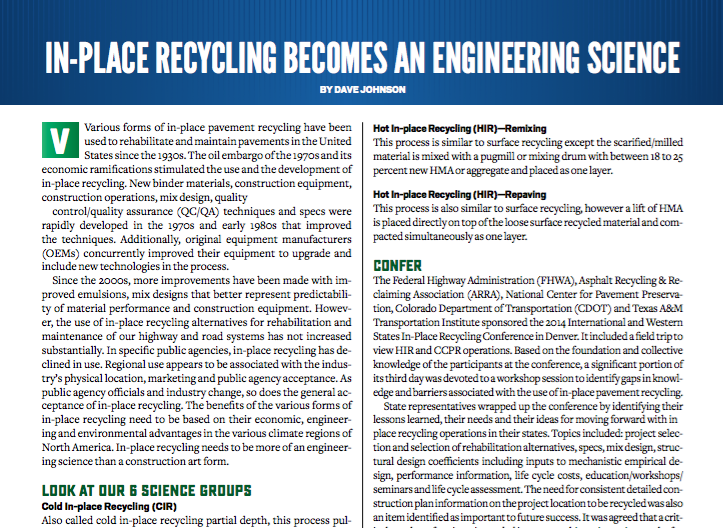In-Place Recycling Becomes an Engineering Science
BY Dave Johnson

Various forms of in‐place pavement recycling have been used to rehabilitate and maintain pavements in the United States since the 1930s. The oil embargo of the 1970s and its economic ramifications stimulated the use and the development of in‐place recycling. New binder materials, construction equipment, construction operations, mix design, quality control/quality assurance (QC/QA) techniques and specs were rapidly developed in the 1970s and early 1980s that improved the techniques. Additionally, original equipment manufacturers (OEMs) concurrently improved their equipment to upgrade and include new technologies in the process.
Since the 2000s, more improvements have been made with improved emulsions, mix designs that better represent predictability of material performance and construction equipment. However, the use of in‐place recycling alternatives for rehabilitation and maintenance of our highway and road systems has not increased substantially. In specific public agencies, in‐place recycling has declined in use. Regional use appears to be associated with the industry’s physical location, marketing and public agency acceptance. As public agency officials and industry change, so does the general acceptance of in‐place recycling. The benefits of the various forms of in‐place recycling need to be based on their economic, engineering and environmental advantages in the various climate regions of North America. In‐place recycling needs to be more of an engineering science than a construction art form.
Look at Our 6 Science Groups
Cold In-place Recycling (CIR)
Also called cold in-place recycling partial depth, this process pulverizes 2 to 5 inches of the asphalt-bound layers in a pavement. It adds a recycling agent such as emulsified asphalt or foamed asphalt, mixes the recycling agent and pulverized/sized material in place, and performs laydown and compaction.
Cold Central Plant Recycling (CCPR)
For this process, existing stockpiles of recycled materials are mixed in a stationary recycling unit or a central plant pugmill. The difference between this process and CIR is the materials are processed off site rather than on the road. CCPR and CIR are often combined and referred to as cold recycling.
Full Depth Reclamation (FDR)
Also called cold in-place recycling full depth, this process pulverizes 6 to 12 inches of asphalt-bound layers and a portion of the underlying materials, with or without the addition of a stabilizer such as Portland cement, lime, emulsified asphalt or foamed asphalt, and performs spreading and compaction.
Hot In-place Recycling (HIR)—Surface Recycling
This process softens the asphalt-bound surface through heating and scarifying 1 to 2 inches with tines or a milling head. The scarified material is mixed with a rejuvenating/recycling agent, placed with a standard asphalt paver and compacted.
Hot In-place Recycling (HIR)—Remixing
This process is similar to surface recycling except the scarified/milled material is mixed with a pugmill or mixing drum with between 18 to 25 percent new HMA or aggregate and placed as one layer.
Hot In-place Recycling (HIR)—Repaving
This process is also similar to surface recycling, however a lift of HMA is placed directly on top of the loose surface recycled material and compacted simultaneously as one layer.
Confer
The Federal Highway Administration (FHWA), Asphalt Recycling & Reclaiming Association (ARRA), National Center for Pavement Preservation, Colorado Department of Transportation (CDOT) and Texas A&M Transportation Institute sponsored the 2014 International and Western States In-Place Recycling Conference in Denver. It included a field trip to view HIR and CCPR operations. Based on the foundation and collective knowledge of the participants at the conference, a significant portion of its third day was devoted to a workshop session to identify gaps in knowledge and barriers associated with the use of in-place pavement recycling.
State representatives wrapped up the conference by identifying their lessons learned, their needs and their ideas for moving forward with in‐place recycling operations in their states. Topics included: project selection and selection of rehabilitation alternatives, specs, mix design, structural design coefficients including inputs to mechanistic empirical design, performance information, life cycle costs, education/workshops/seminars and life cycle assessment. The need for consistent detailed construction plan information on the project location to be recycled was also an item identified as important to future success. It was agreed that a critical number of projects is needed in a geographic region to insure the future viability of these recycling technologies.
Researchers have identified additional projects and drafted proposals to encompass all forms of in‐place recycling as well as to focus on the individual forms of CIR, FDR and HIR. The 2014 workshop was both well received and highly rated by its participants. The workshop and the DOT members who attended generated significant momentum that industry can capitalize on to demonstrate the engineering, economic and environmental benefits of pavement recycling technology. It’s important for agencies to maintain and even increase this momentum.
Dave Johnson is an Asphalt Institute senior regional engineer based in Montana.
—
Save the Date
The second International and Western States In‐Place Recycling Conference will be held in
Denver Oct. 19, 2016. Travel funding assistance is being organized to afford key state and local agency staff the ability to participate in this event. The conference will highlight the progress made since the last conference, including the successful research efforts initiated at the 2014 conference. This year’s agenda will focus on the latest data on
- in‐place recycling performance,
- structural modeling,
- recommended mix design methods,
- life cycle cost and sustainability, and
- implementation assistance.
More information: rockymountainasphalt.com.
